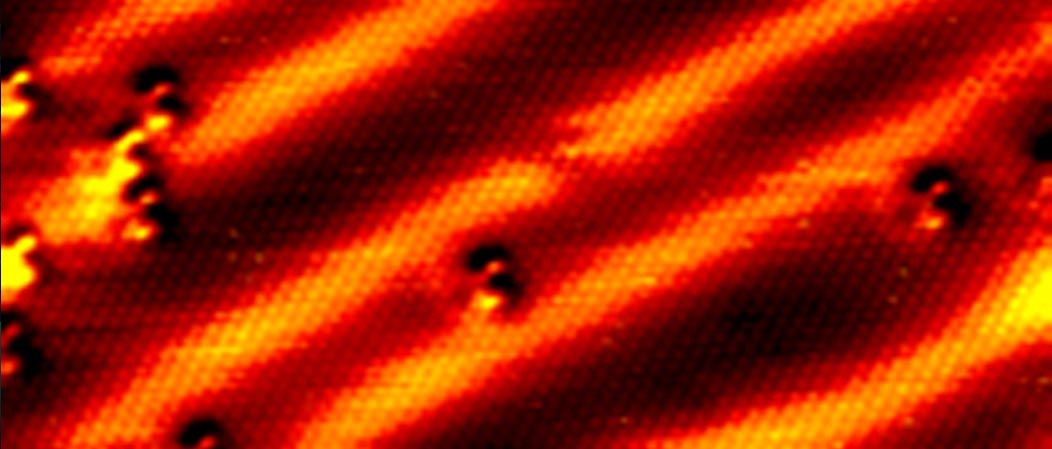IPES, BIS
Photoelectron Spectroscopy, especially UPS or ARPES has proven to be a perfect method to analyze the electronic structure of metal and semiconductor surfaces. Also the interface formation can be studied in detail, when taking spectra during the stepwise growth of a thin film on a substrate. by this important key parameters for devices, like Fermi level position, position of the valence band maximum, band bending, doping and the work function and the position of the vacuum level with respect to the valence band maximum can be determined. Because of the analysis of electrons taken from the solid surface, unfortunately this is limted to occupied states. The unoccupied part of the band structure, mainly the states between Fermi level and vacuum level cannot be reached. Thus the electron affinity, the conduction band minimum and the band gap cannot directly be determined. This is unfortunate, because for several semiconductor devices, like solar cells, the full set of information is needed to derive significant data for material optimization. To measure the unoccupied states, they would have to be filled with electrons first. There are three methods, that can fullfill this task without giving up the surface sensitivity, X-ray absorption spectroscopy (requiring a tunable light source, in most cases a laser), Two-photon photoemission spectroscopy (requiring two laser pulses with tunable energy and time delay) and Inverse Photoelectron Spectroscopy (IPES).
For IPES electrons are emitted from an (as monochromatic as possible) electron source. These electrons are impinging on the sample surface. Most of these electrons are elastically or inelastically scattered at the surface, but a small number (depending on the kinetic energy the efficiency or yield is about four orders of magnitude lower than in UPS) of the incident electrons will relax into the formerly unoccupied states under emission of a photon. The photon energy is equal to the kinetic energy of the initial electron plus the energy of the unoccupied state with respect to the vacuum level. Using an energy resolving photon detector a spectrum of the unoccupied states can be recorded. The energy resolution is determined by the combined resolution of the detetcor and the electron source and is typically about 1eV. These spectra can also be recorded angle or k-resolved. Then the method will be named ARIPES or KRIPES.
As a detector there are typically three different choices around. The first and (with respect to energy resolution) best choice would be a classical crystal or grating monochromator. This is very bulky, expensive and gives (due to limited acceptance angles) only a small signal intensity. Therefore most realizations either use an X-ray monochromator in reversed setup, with a channelplate in the position of the X-ray source. This can be done in the same X-ray monochromator used for XPS. In this case the detection energy is constant and equal to the X-ray energy, so typically 1500eV. For this reason the electron source has to run at this energy. The combination of the FOCUS 500 monochromator source with BIS detector upgrade and the EQ 22/35 electron source is a simple and efficient way of integrating this technique into SPECS PES systems. Because of the constant detection energy the initial electron kinetic energy has to be swept to record a spectrum. Because of the constant detection energy and X-rays produced this method is often called X-ray Bremsstrahlung Isochromate Spectroscopy (X-BIS). Although the cross section for relaxation of the electrons in unoccupied states is pretty low due to the high kinetic energy, the efficiency of the monochromator and the electron beam currents are pretty high, at pretty good energy resolutions of 200-500meV. On the other hand the beam load on the sample also is quite high. Beam damages, expecially in organic materials have a higher probability. Another choice of detector is a band-pass detector for VUV light (around 10eV photon energy). This is realized either be Geiger-Mueller type counters or a sensitized channeltron or channelplate both additionally equipped with a low pass window. The efficiency for relaxation is higher, but the beam currents are lower. So low count rate at lower probability for beam damages. Unfortunately the energy resolution of the detcors is only about 1-1.5 eV, giving an overall energy resolution of about 1.2 eV. Also here the detection energy is constant, and to record a spectrum the electron source is swept. Accordingly this is named UV-BIS. SPECS can also offer this package.
